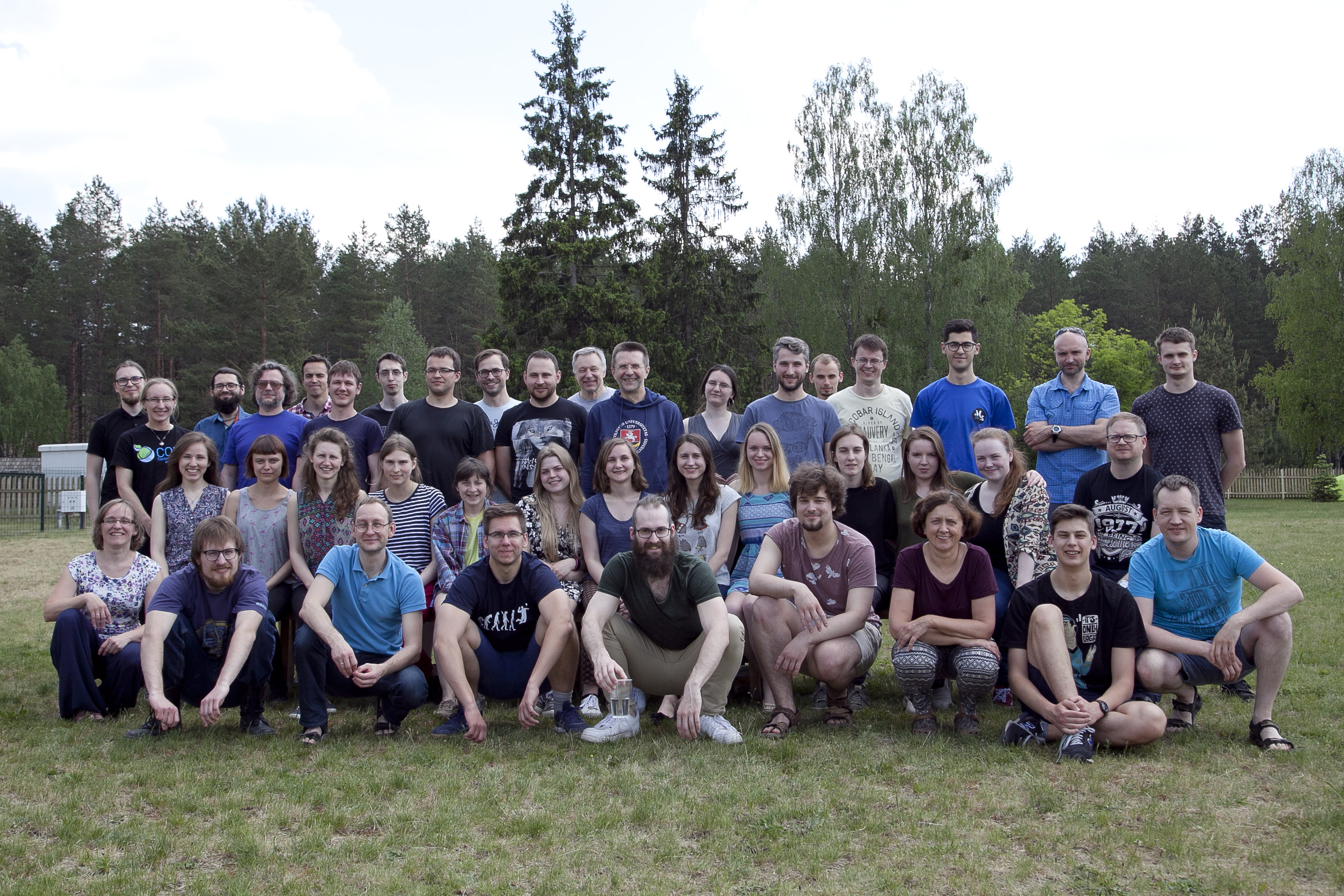Projects
Department of Protein - DNA Interactions
|
| Chief Scientist and Head:
Tel. +370-5-2234354 | Lab. Members: Dr. Giedrius Gasiūnas Dr. Saulius Gražulis Dr. Tautvydas Karvelis Dr. Elena Manakova Dr. Andrius Merkys Dr. Giedrius Sasnauskas Dr. Arūnas Šilanskas Dr. Tomas Šinkūnas Dr. Giedrė Tamulaitienė Dr. Gintautas Tamulaitis Dr. Paulius Toliušis Dr. Mindaugas Zaremba Dr. Evelina Zagorskaitė Dr. Marijonas Tutkus Dr. Nina Urbelienė Dr. Danielis Rutkauskas Dr. Marija Jankunec Dalia Smalakytė, MSc Inga Songailienė, MSc Gediminas Drabavičius, MSc Rimantė Žedaveinytė, MsC Lina Aitmanaitė, MSc Rūta Zinkevičiūtė, MSc Graduate Students: Greta Bigelytė, MSc Gediminas Drabavičius, MSc Edvardas Golovinas, MSc Irmantas Mogila, MSc Antanas Vaitkus, MSc Dalia Smalakytė, MSc Donata Dakinevičien,ė MSc Algirdas Grybauskas, MSc Gediminas Drabavičiu,s MSc Jonas Juozapaitis, MSc Undergraduate students: Simonas Ašmontas Konstantyj Keda Danas Klimavičius Aurimas Kopūstas Eglė Kupčinskaitė Danguolė Norkūnaitė Džiugas Sabonis Rugilė Ivanickaitė Ugnė Gaižauskaitė Tomas Venclovas Gytis Druteika Aistė Petrauskaitė Karolis Sabutis Justė Paksaitė Ugnė Tylenytė Marija Duchovskytė Technical assistant: Ana Tunevič Jadvyga Matulevič Ilinykh |
 | ||
Research overview | ||
The overall research theme in our lab is the structural and functional characterization of enzymes and enzyme assemblies that contribute to the bacteria defense systems which target invading nucleic acids. In particularly, we are involved in the deciphering structural and molecular mechanisms of restriction enzymes, and the molecular machinery involved in the CRISPR function. We are using X-ray crystallography, mutagenesis, and functional biochemical and biophysical assays to gain information on these systems.
Projects
Structure and molecular mechanisms of CRISPR/Cas systems.
Recently, an adaptive microbial immune system CRISPR (clustered regularly interspaced short palindromic repeats) has been identified that provides acquired immunity against viruses and plasmids. CRISPR represents a family of DNA repeats present in most bacterial and archaeal genomes. CRISPR loci usually consist of short and highly conserved DNA repeats, typically 21 to 48 bp, repeated from 2 to up to 250 times. The repeated sequences, typically specific to a given CRISPR locus, are interspaced by variable sequences of constant and similar length, called spacers, usually 20 to 58 bp. CRISPR repeat-spacer arrays are typically located in the direct vicinity of cas (CRISPR associated) genes. Cas genes constitute a large and heterogeneous gene family which encodes proteins that often carry functional nucleic-acid related domains such as nuclease, helicase, polymerase and nucleotide binding. The CRISPR/Cas system provides acquired resistance of the host cells against bacteriophages. In response to phage infection, some bacteria integrate new spacers that are derived from phage genomic sequences, which results in CRISPR-mediated phage resistance. Many mechanistic steps involved in invasive element recognition, novel repeat manufacturing, and spacer selection and integration into the CRISPR locus remain uncharacterized.
Structure and function of restriction endonucleases
Restriction and modification systems commonly act as the first line of intracellular defense against foreign DNA and function as sentries that guard bacterial cells against invasion by bacteriophage. R-M systems typically consist of two complementary enzymatic activities, namely restriction endonuclease (REase) and methyltransferase (MTase). In typical RM systems REase cuts foreign DNA but does not act on the host genome because target sites for REase are methylated by accompanying MTase. REases from 4000 bacteria species with nearly 330 differing specificities have been characterised. REases have now gained widespread application as indispensable tools for the in vitro manipulation and cloning of DNA. However, much less is known about how they achieve their function.
In the Laboratory of Protein-DNA Interactions we focus on the structural and molecular mechanisms of restriction enzymes. Among the questions being asked are: How do the restriction enzymes recognize the particular DNA sequence? What common structural principles exist among restriction enzymes that recognize related nucleotide sequences? How are the sequence recognition and catalysis coupled in the function of restriction enzymes? Answers to these questions are being sought using X-ray crystal structure determination of restriction enzyme-DNA complexes, site-directed mutageneses and biochemical studies to relate structure to function.
Crystallography Open Database COD
The COD project (abbreviated from the "Crystallography Open Database", http://www.crystallography.net/) aims at collecting in a single open access database all organic, inorganic and metal organic structures (except for the structures of biological macromolecules that are available at the PDB). (read more ...)
Publications
Publications 2011 – 2016
- Jakutyte-Giraitiene, L. & Gasiunas, G., Design of a CRISPR-Cas system to increase resistance of Bacillus subtilis to bacteriophage SPP1 Journal of Industrial Microbiology & Biotechnology, 2016, 1-6. (PDF)
- Kazlauskiene, M., Tamulaitis, G., Kostiuk, G., Venclovas, Č. & Siksnys, V., Spatiotemporal Control of Type III-A CRISPR-Cas Immunity: Coupling DNA Degradation with the Target RNA Recognition. Mol Cell, 2016, vol. 62, 295-306. (PDF)
- Labrie, V., Buske, O. J., Oh, E., Jeremian, R., Ptak, C., Gasiūnas, G., Maleckas, A., Petereit, R., Žvirbliene, A., Adamonis, K., Kriukienė, E., Koncevičius, K., Gordevičius, J., Nair, A., Zhang, A., Ebrahimi, S., Oh, G., Šikšnys, V., Kupčinskas, L., Brudno, M. & Petronis, A., Lactase nonpersistence is directed by DNA-variation-dependent epigenetic aging. Nat Struct Mol Biol, 2016, vol. 23, 566-573. (PDF)
- Müller, M., Lee, C. M., Gasiunas, G., Davis, T. H., Cradick, T. J., Siksnys, V., Bao, G., Cathomen, T. & Mussolino, C., Streptococcus thermophilus CRISPR-Cas9 Systems Enable Specific Editing of the Human Genome. Mol Ther, 2016, vol. 24, 636-644. (PDF)
- Siksnys, V. & Gasiunas, G., Rewiring Cas9 to Target New PAM Sequences. Mol Cell, 2016, vol. 61, 793-794. (PDF)
- Glemzaite, M., Balciunaite, E., Karvelis, T., Gasiunas, G., Grusyte, M. M., Alzbutas, G., Jurcyte, A., Anderson, E. M., Maksimova, E., Smith, A. J., Lubys, A., Zaliauskiene, L. & Siksnys, V., Targeted gene editing by transfection of in vitro reconstituted Streptococcus thermophilus Cas9 nuclease complex. RNA Biol, 2015, vol. 12, 1-4. (PDF)
- Karvelis, T., Gasiunas, G., Young, J., Bigelyte, G., Silanskas, A., Cigan, M. & Siksnys, V., Rapid characterization of CRISPR-Cas9 protospacer adjacent motif sequence elements. Genome Biol, 2015, vol. 16, 253. (PDF)
- Rutkauskas, M., Sinkunas, T., Songailiene, I., Tikhomirova, M. S., Siksnys, V. & Seidel, R., Directional R-Loop Formation by the CRISPR-Cas Surveillance Complex Cascade Provides Efficient Off-Target Site Rejection. Cell Rep, 2015. (PDF)
- Sasnauskas, G., Zagorskaitė, E., Kauneckaitė, K., Tamulaitiene, G. & Siksnys, V., Structure-guided sequence specificity engineering of the modification-dependent restriction endonuclease LpnPI. Nucleic Acids Res, 2015, vol. 43, 6144-6155. (PDF)
- Sinkunas, T., Gasiunas, G. & Siksnys, V., Cas3 nuclease-helicase activity assays. Methods Mol Biol, 2015, vol. 1311, 277-291. (PDF)
- Tamulaitis, G., Rutkauskas, M., Zaremba, M., Grazulis, S., Tamulaitiene, G. & Siksnys, V., Functional significance of protein assemblies predicted by the crystal structure of the restriction endonuclease BsaWI. Nucleic Acids Res, 2015, vol. 43, 8100-8110. (PDF)
- Zaremba, M. & Siksnys, V., An Engineered SS Bridge Blocks the Conformational Change Required for the Nuclease Activity of BfiI. Biochemistry, 2015, vol. 54, 5340-5347. (PDF)
- Zaremba, M., Toliusis, P., Grigaitis, R., Manakova, E., Silanskas, A., Tamulaitiene, G., Szczelkun, M. D., Siksnys, V., Tamulaitiene, G., Silanskas, A., Grazulis, S., Zaremba, M. & Siksnys, V., DNA cleavage by CgII and NgoAVII requires interaction between N- and R-proteins and extensive nucleotide hydrolysis. Nucleic Acids Res, 2015, vol. 43, 3405. (PDF)
- Gasiunas, G., Sinkunas, T. & Siksnys, V., Molecular mechanisms of CRISPR-mediated microbial immunity. Cell Mol Life Sci, 2014, vol. 71, 449-465. (PDF)
- Golovenko, D., Manakova, E., Zakrys, L., Zaremba, M., Sasnauskas, G., Gražulis, S. & Siksnys, V., Structural insight into the specificity of the B3 DNA-binding domains provided by the co-crystal structure of the C-terminal fragment of BfiI restriction enzyme. Nucleic Acids Res, 2014, vol. 42, 4113-4122. (PDF)
- Rutkauskas, D., Petkelyte, M., Naujalis, P., Sasnauskas, G., Tamulaitis, G., Zaremba, M. & Siksnys, V., Restriction enzyme Ecl18kI-induced DNA looping dynamics by single-molecule FRET. J Phys Chem B, 2014, vol. 118, 8575-8582. (PDF)
- Szczelkun, M. D., Tikhomirova, M. S., Sinkunas, T., Gasiunas, G., Karvelis, T., Pschera, P., Siksnys, V. & Seidel, R., Direct observation of R-loop formation by single RNA-guided Cas9 and Cascade effector complexes. Proc Natl Acad Sci U S A, 2014, vol. 111, 9798-9803. (PDF)
- Tamulaitiene, G., Silanskas, A., Grazulis, S., Zaremba, M. & Siksnys, V., Crystal structure of the R-protein of the multisubunit ATP-dependent restriction endonuclease NgoAVII. Nucleic Acids Res, 2014, vol. 42, 14022-14030. (PDF)
- Tamulaitis, G., Kazlauskiene, M., Manakova, E., Venclovas, Č., Nwokeoji, A. O., Dickman, M. J., Horvath, P. & Siksnys, V., Programmable RNA shredding by the type III-A CRISPR-Cas system of Streptococcus thermophilus. Mol Cell, 2014, vol. 56, 506-517. (PDF)
- Zagorskaitė, E. & Sasnauskas, G., Chemical Display of Pyrimidine Bases Flipped Out by Modification-Dependent Restriction Endonucleases of MspJI and PvuRts1I Families PLoS ONE, 2014, vol. 9, e114580. (PDF)
- Zaremba, M., Toliusis, P., Grigaitis, R., Manakova, E., Silanskas, A., Tamulaitiene, G., Szczelkun, M. D. & Siksnys, V., DNA cleavage by CgII and NgoAVII requires interaction between N- and R-proteins and extensive nucleotide hydrolysis. Nucleic Acids Res, 2014, vol. 42, 13887-13896. (PDF)
- Gasiunas, G. & Siksnys, V., RNA-dependent DNA endonuclease Cas9 of the CRISPR system: Holy Grail of genome editing? Trends Microbiol., 2013, vol. 21, 562-7. ()
- Horvath, P., Gasiunas, G., Siksnys, V. & Barrangou, R., Applications of the Versatile CRISPR-Cas Systems , 2013, 267-286. (PDF)
- Karvelis, T., Gasiunas, G., Miksys, A., Barrangou, R., Horvath, P. & Siksnys, V., crRNA and tracrRNA guide Cas9-mediated DNA interference in Streptococcus thermophilus RNA Biol., 2013, vol. 10, 841-51. ()
- Karvelis, T., Gasiunas, G. & Siksnys, V., Programmable DNA cleavage in vitro by Cas9 Biochem. Soc. Trans., 2013, vol. 41, 1401-6. ()
- Sinkunas, T., Gasiunas, G., Waghmare, S. P., Dickman, M. J., Barrangou, R., Horvath, P. & Siksnys, V., In vitro reconstitution of Cascade-mediated CRISPR immunity in Streptococcus thermophilus. EMBO J, 2013. (PDF)
- Baranauskas, A., Paliksa, S., Alzbutas, G., Vaitkevicius, M., Lubiene, J., Letukiene, V., Burinskas, S., Sasnauskas, G. & Skirgaila, R., Generation and characterization of new highly thermostable and processive M-MuLV reverse transcriptase variants Protein Engineering Design and Selection, 2012, vol. 25, 657-668. (PDF)
- Gasiunas, G., Barrangou, R., Horvath, P. & Siksnys, V., Cas9-crRNA ribonucleoprotein complex mediates specific DNA cleavage for adaptive immunity in bacteria. Proc Natl Acad Sci U S A, 2012, vol. 109, E2579-E2586. (PDF)
- Manakova, E., Grazulis, S., Zaremba, M., Tamulaitiene, G., Golovenko, D. & Siksnys, V., Structural mechanisms of the degenerate sequence recognition by Bse634I restriction endonuclease. Nucleic Acids Res, 2012, vol. 40, 6741-6751. (PDF)
- Silanskas, A., Zaremba, M., Sasnauskas, G. & Siksnys, V., Catalytic activity control of restriction endonuclease--triplex forming oligonucleotide conjugates. Bioconjug Chem, 2012, vol. 23, 203-211. (PDF)
- Sukackaite, R., Grazulis, S., Tamulaitis, G. & Siksnys, V., The recognition domain of the methyl-specific endonuclease McrBC flips out 5-methylcytosine. Nucleic Acids Res, 2012, vol. 40, 7552-7562. (PDF)
- Zaremba, M., Sasnauskas, G. & Siksnys, V., The link between restriction endonuclease fidelity and oligomeric state: a study with Bse634I. FEBS Lett, 2012, vol. 586, 3324-3329. (PDF)
- Kostiuk, G., Sasnauskas, G., Tamulaitiene, G. & Siksnys, V., Degenerate sequence recognition by the monomeric restriction enzyme: single mutation converts BcnI into a strand-specific nicking endonuclease. Nucleic Acids Res, 2011, vol. 39, 3744-3753. (PDF)
- Sapranauskas, R., Gasiunas, G., Fremaux, C., Barrangou, R., Horvath, P. & Siksnys, V., The Streptococcus thermophilus CRISPR/Cas system provides immunity in Escherichia coli. Nucleic Acids Res, 2011, vol. 39, 9275-9282. (PDF)
- Sasnauskas, G., Kostiuk, G., Tamulaitis, G. & Siksnys, V., Target site cleavage by the monomeric restriction enzyme BcnI requires translocation to a random DNA sequence and a switch in enzyme orientation. Nucleic Acids Res, 2011, vol. 39, 8844-8856. (PDF)
- Silanskas, A., Foss, M., Wende, W., Urbanke, C., Lagunavicius, A., Pingoud, A. & Siksnys, V., Photocaged variants of the MunI and PvuII restriction enzymes. Biochemistry, 2011, vol. 50, 2800-2807. (PDF)
- Sinkunas, T., Gasiunas, G., Fremaux, C., Barrangou, R., Horvath, P. & Siksnys, V., Cas3 is a single-stranded DNA nuclease and ATP-dependent helicase in the CRISPR/Cas immune system. EMBO J, 2011, vol. 30, 1335-1342. (PDF)






